The best rain ponchos in 2024, tried and tested
Content is created by CNN Underscored’s team of editors who work independently from the CNN newsroom. When you buy through links on our site, CNN and its syndication partners may earn a commission. Learn more
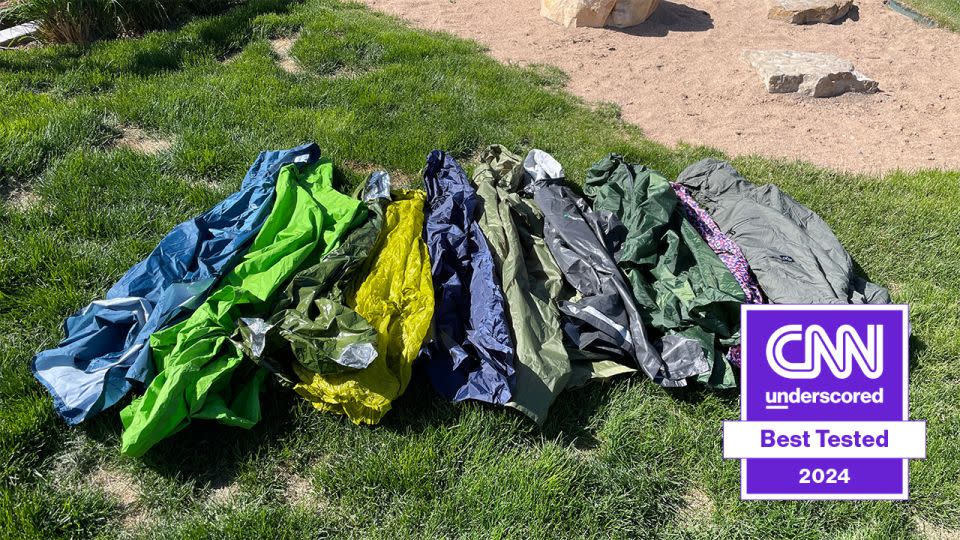
When the weather forecast turns wet and soggy, you don’t want to be caught in the rain without some form of protection. While a rain jacket may be the ideal long-term choice, a poncho is a solid alternative. Ponchos can be more packable and lightweight, but many are also versatile in ways that some rain jackets can’t compete with.
We tested 10 ponchos from well-known brands like Sea to Summit and Frogg Toggs, along with other top-rated ponchos sold via Amazon. We analyzed their waterproofness, breathability and general fit. After taking each poncho through rigorous tests, one stood out as the overall best.
Anyoo Waterproof Rain Poncho
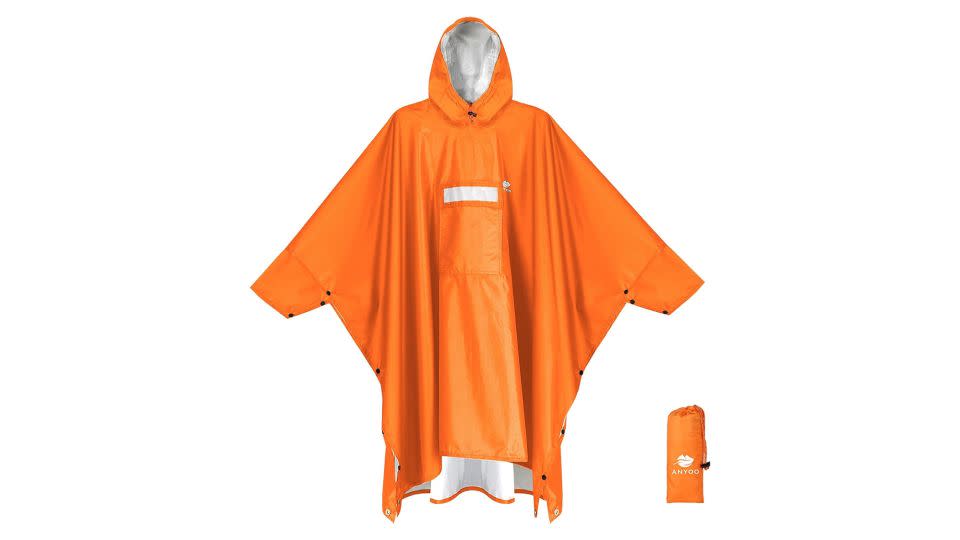
The Anyoo Poncho has all the features (and extra features) a poncho should have, all at a highly affordable price. It has grommets on the corners in case you need to use it as an emergency shelter, is a good length to fit a backpack underneath and is lightweight and packable.
Best rain poncho: Anyoo Waterproof Rain Poncho
From $13 at Amazon
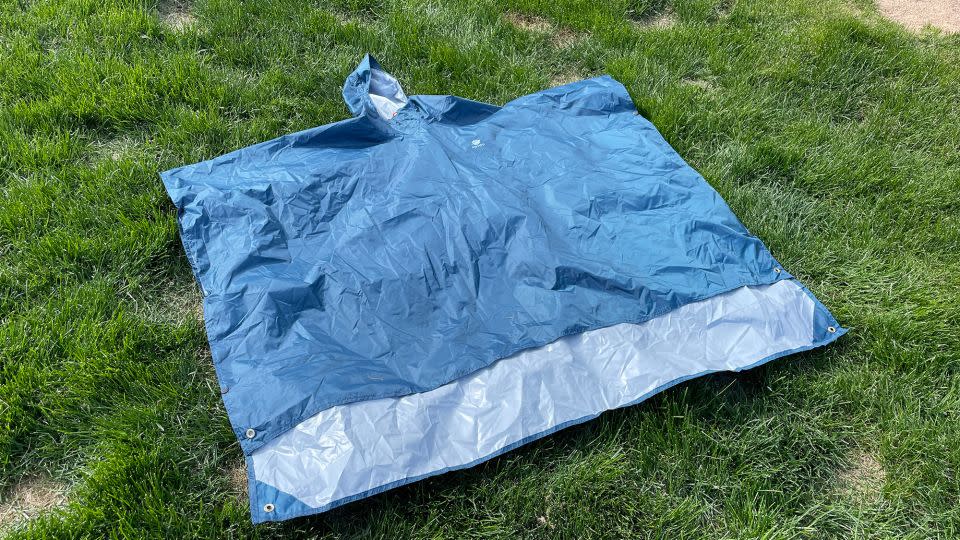
For a lightweight, waterproof poncho with useful features, the Anyoo Poncho is a reliable companion for your next outdoor adventure — and it’s highly affordable, too. Across all our tests (waterproofness, breathability and backpack fit) it scored highly and stood out for overall fit and extra features.
To test waterproofness fairly, we wore each poncho in the shower for five minutes and ensured all areas of it were soaked with the shower stream. Waterproofness for a poncho is arguably the most important factor, and the Anyoo passed the test easily. At no point did water seep in from any seams or sneak in any side openings. It’s made from a lightweight, ripstop polyester with a waterproof, eco-friendly TPU coating and has sealed seams.
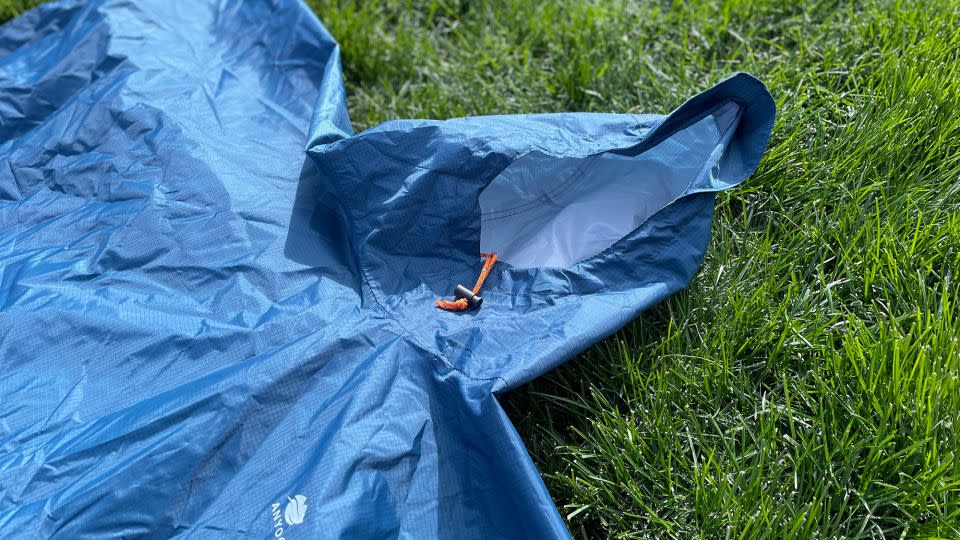
During the shower test, we also loved how protective its hood was. The Anyoo’s hood has a small, malleable brim (a flexible brim means packing it up is much easier) and a cinch drawstring. With the brim and drawstring, I could secure the hood completely around my face to shield me from dripping water.
This poncho is also lightweight and breathable, meaning you won’t get too muggy underneath when humidity starts to rise. We tested breathability by wearing the Anyoo Poncho on a treadmill for five minutes at a pace and incline that mimicked hiking. With the large opening at the bottom and three snaps at each side, air flow was acceptable to keep our lower half feeling great. We felt a bit of sweat buildup near our shoulders, but nothing too concerning; this was still rated as one of the most breathable ponchos we tested.
The Anyoo is not the lightest poncho we tested, however — that rank goes to the Sea to Summit Ultra-Sil Nano Poncho and Prepared4X Emergency Poncho — but it is in the bottom half of our pool at 300 grams. We still think it’s light enough for everyone except ultralight backpackers, and because it has some heft to it, it seems durable enough to use as a tarp on rough ground or to squeeze past tight trees without issue. Some of that weight is also due to the four grommets on each corner of the poncho. Although we ideally won’t use our poncho as an emergency shelter, having the option to throw it up as a tarp or stake it in as a ground sheet is a nice touch.
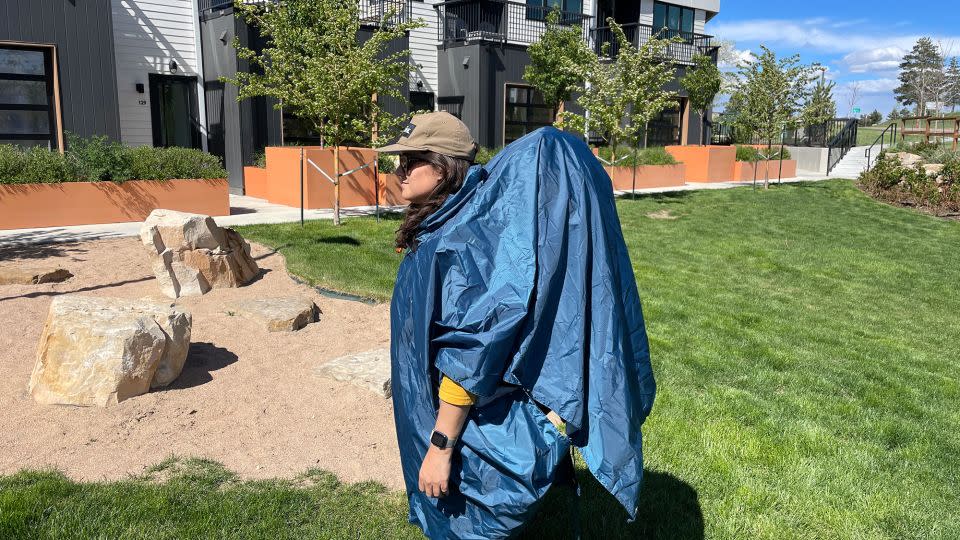
For fit, the Anyoo is a size that works well with a pack on or without. To test with a pack, we wore a 65-liter Osprey Aura AG women’s backpack that was full, but not stuffed. The poncho easily went over the pack and still had a good length in the back. Without a pack on, it wasn’t too long, which was the case with some of the larger models we tested. The front is 39 inches long and the back is 47 inches. On my 5-foot, 5-inch frame, this poncho hit about my lower calf in the back and mid-shin in the front, which meant it wasn’t getting in the way of my feet while walking. The sleeves were also a nice length, as they went to just above the wrists, rather than to my forearms or elbows. With wrist-length sleeves, I could tuck my hands up into the sleeves if I wanted my hands to stay dry while hiking. There’s only one size (which was standard across nearly all ponchos we tested), so the amount of coverage you’ll get depends on your height. We think this one is sized quite well and should fit most people.
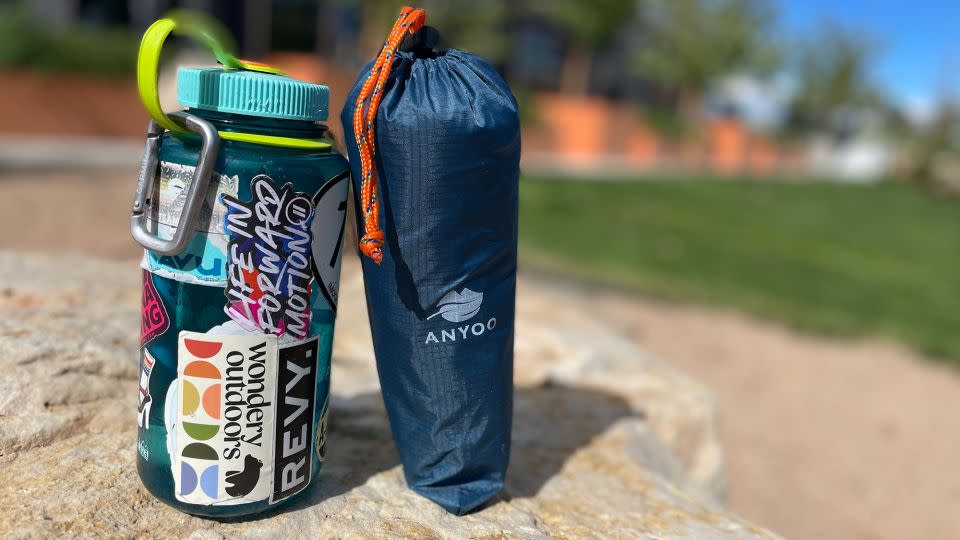
One thing to consider when using a poncho is how easily and tightly it stuffs away, because even if you don’t think you’ll need it, carrying one is crucial. The Anyoo has a separate stuff sack about the size of a 32-ounce Nalgene water bottle and is easy to put away. When compared to other ponchos we tested, the Anyoo’s packed size was right in the middle of the pack — the Voited Packable Rain Poncho and the Helikon-Tex Swagman Roll Poncho were much larger when packed away, but the rest were about the same size as or a bit smaller than our winner.
With grommets on the corners for shelter use, a good length to fit a backpack underneath and a lightweight and packable design, the Anyoo is a secure choice for anyone, whether you need an emergency cover for a sporting event or you’re an avid outdoor enthusiast. Priced at just $16 at Amazon and with 24 color options, it’s a value-for-money investment in your comfort and safety.
Everything you need to know about rain ponchos
Although choosing between a rain jacket or a rain poncho might not seem like a big deal, there are a few critical differences to know before you click “add to cart.”
Ponchos definitely look goofier than rain jackets, but if you don’t care about aesthetics as much, there are a lot of pros to wearing one. Both should keep you dry, but the main variation is how much coverage you’ll get. Most rain jackets sit at about waist height or a little longer, whereas ponchos usually fall to your knees or below. A longer poncho is helpful to keep your bottom half dry as well as your top; with a raincoat, sometimes you can run into the problem of water dripping off your coat and down to your pants or into your shoes. When sporting a poncho, your calves and feet could still get wet, but the rest of your body should stay dry.
You will sacrifice some breathability with a poncho, though not all. Most rain jackets are made from porous materials that don’t allow water droplets in but allow sweat vapor to seep out. Ponchos are often made from nylon or polyester, so the breathability isn’t as comparable to a high-tech rain jacket. However, because the poncho is much more open, there is still some breathability at the bottom and on the sides.
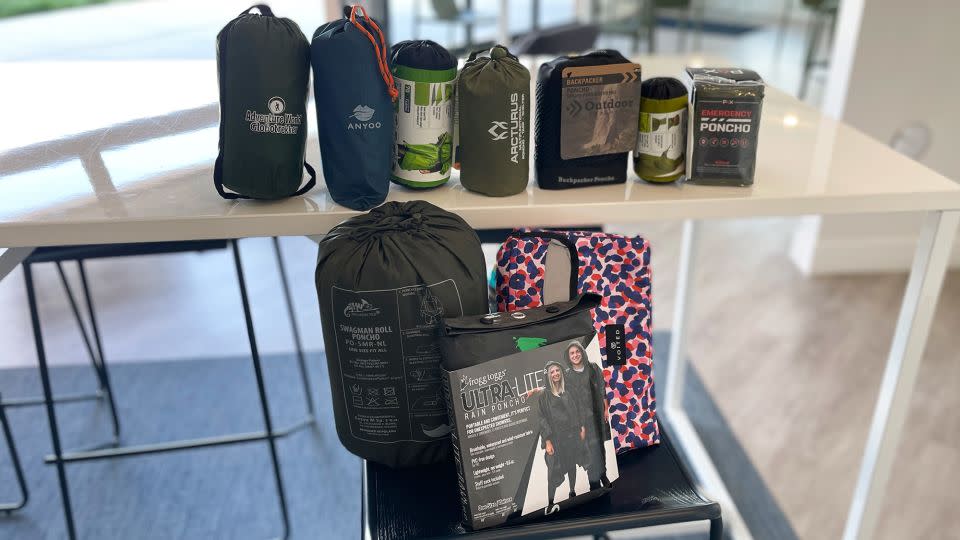
Many rain jackets also have a durable water-repellent (DWR) finish so water beads up and rolls off. DWR finishes eventually wear off and must be reactivated by washing with a technical detergent like Nikwax. About half the ponchos we tested have some sort of waterproof coating. Ponchos without a DWR coating can be saturated with rain more quickly, but you don’t have to worry about reactivating any water-repellent finish.
If you’re looking for rain protection during a hike, backpacking-specific ponchos have a larger fit to cover your pack completely. This eliminates the need for a rain cover for your backpack and makes getting caught in a sudden rain storm much more manageable — rather than putting on your rain jacket and a pack cover, you can pop that poncho over everything and be good to go.
Overall, you’ll spend much less on a poncho than a rain jacket. Most rain jackets start at around $150 (but can reach upwards of $275 or more), while the average price for the ponchos we tested was about $45, with the winner being around only $14.
Beyond a poncho’s ability to keep you dry, other features to look for include the overall length and fit (including if it fits over a backpack), any extra pockets or a hood and how easily it packs up. No one wants to get rained on, but you should always bring protection, so finding a lightweight, small and well-fitting poncho is crucial.
How we tested
To determine which poncho is the best, we tested everything from waterproofness and breathability to how they fit over a 65-liter pack. We looked at two main categories for testing: performance and versatility. Then, we saw how each poncho stacked up against the others to make a good judgment on which ones are truly worth using. Here’s a full list of all the tests we ran and the qualities we considered.
Performance
Waterproofness: We wore each poncho in the shower for five minutes, ensuring the water hit us from all directions. We had tissues in our hip pockets and the hood up during this test. After getting thoroughly soaked, we noted whether the tissues or our clothes were saturated and how well the hood blocked water from our faces.
Breathability: We wore each jacket on a treadmill for five minutes, walking at a 3 mile per hour pace with a 5% incline to mimic hiking. We judged how sweaty or sticky we felt underneath each poncho.
Weight: We weighed each jacket on a kitchen scale.
Versatility
Pockets and attributes: We counted extra features, such as pockets, hood cinches and brims.
Packability: We packed each poncho into its stuff sack and compared each size.
Fit and length: We considered the poncho’s overall fit, including whether it fits nicely over a large pack and its overall length.
Other rain ponchos we tested
Sea to Summit Nylon Tarp Poncho
$70 at Sea to Summit
The Sea to Summit Nylon Tarp Poncho is the ideal poncho if you are also using it as a shelter. It is made from a thicker, durable nylon fabric that, when used in various forms — like an A-frame, windshield or hammock cover — can easily protect two people from the elements. This larger size also means it easily fits a full pack underneath. And with a simple cinch pull on the bottom back, you can scrunch up the longer backside so it doesn’t hit your ankles when hiking. Even though it is longer, it has many openings on the sides, so the breathability is top-notch.
Because it can be turned into various shelters, the poncho has guy-outs on all four corners and in the middle, plus four snaps on each side. This makes it a slightly heavier poncho at nearly 400 grams, which is almost 100 grams more than our winning cloak. No water got in the poncho, and the hood had a cinching drawstring and a brim with good coverage from a straight downpour of water. Although this is a very nice poncho, the price is a bit steep and the longer length is a bit annoying if you aren’t wearing a huge pack.
Arcturus Rain Poncho
$20 at Amazon
The Arcturus Rain Poncho was a close contender for our top spot. It performed well in the waterproof test and has grommets on each corner of the poncho so you can use it as a tarp or shelter, plus a drawstring cinch to secure the hood. The main issue was how big it was. The front and back of the poncho are both the same length, unlike others we tested, and both sides were long enough to hit my ankles with each step when walking on the treadmill (for reference, I’m 5 feet 5 inches tall).
A larger poncho is excellent if you are also using it as your shelter, but for just rain protection, I found this one to be too large. Because it was so long, its breathability wasn’t ideal since there wasn’t much airflow from the bottom. It is also quite tricky to get back into its stuff sack, though it is a nice, small size — about 8 by 5 inches.
Adventure World Globotrekker Lightweight Backpack Poncho
$35 at Amazon
The Adventure World Globotrekker Lightweight Backpack Poncho is another poncho explicitly designed for backpacking. It has an extra section of fabric that stores away when not in use but can be pulled out to fit over a large backpack easily. Unfortunately, the overall design fell short; when not in use, the extra pack section doesn’t fold flat back into its zippered pocket. And, when wearing just the poncho in the shower test, water gathered where the extra fabric was stored, which made for a heavy pool.
The sleeves were also nice because they were long enough to cover my hands, but because the poncho has sleeves rather than snapping sides, you can’t turn it into a tarp. The Adventure World Globotrekker poncho has some useful features, but the fit and design weren’t working. It seemed pretty unnecessary when a larger poncho, like the winning Anyoo, covered a pack just fine without having to deal with any extra fabric to pack away.
Sea to Summit Ultra-Sil Nano Poncho
$100 at Sea to Summit
If you like ultralight trekking, you can’t go wrong with the Ultra-Sil Nano Poncho by Sea to Summit. It weighs just 100 grams and packs down to about the size of a soda can into an included stuff sack. Even though it’s extremely lightweight, the material is a durable nylon that is waterproof and breathable. Because of the slippery material, we could feel our sweat gathering inside the poncho during the treadmill walk, but it is still one of our most breathable options.
Its features include one cinch pull below the chin, which helped keep water out of my face, and a small brim that seems flimsy but performs surprisingly well. This poncho is also very long and can easily fit a large backpack underneath with plenty of extra room. Without a pack on, the poncho went to about my ankles in the back, which was nice for full and ample coverage. If you want a lightweight option that could also double as a tarp with guy attachment points, check out the Ultra-Sil Nano Tarp Poncho.
Voited Packable Rain Poncho
$80 $24 at Voited
Even though the Voited Packable Rain Poncho is too heavy and bulky when packed down to use while hiking or backpacking, it easily takes the spot for the best commuter poncho. It stuffs easily into its own pocket, which you can then attach to your bike’s handlebars with two small Velcro loops, and you even get an extra zipper pocket to hold any small items. The stuff sack and poncho have reflective details for good visibility when riding in rainy weather, and you can easily fit a daypack underneath if you need.
The hood has two cinches in the front and a back cinch to fully secure it around your head or a helmet. Plus, the brim is stiff, so no water dripped into my face during the shower test, and the poncho’s sleeves are very long, so my hands could be fully covered. Along with cinches on the hood, other features include a zippered neck for added breathability or extra coverage, a large zippered kangaroo pocket, another large zippered bucket pocket and durable material akin to a rain jacket. Another awesome feature? The four corners have grommets so you can easily stake the poncho down to use as a blanket during a picnic or park day. If weight and packability aren’t a huge issue, this is a great option to bring to the park, a sports game or the local music fest.
Prepared4X Emergency Poncho, 4-Pack
$20 at Amazon
Choose this poncho to stick in your first aid or emergency kit. The Prepared4X Emergency Poncho is made from waterproof mylar so that you can stay warm and dry in even the toughest conditions. It’s thin and lightweight (100 grams), which means it packs down to about the size of a deck of cards, but its durability is questionable. It’s quite crinkly-sounding and -feeling, too, but it fared well in terms of its waterproofness and breathability.
When performing the shower test, my hands and forearms got wet since the poncho only went down to just past the elbows, which wouldn’t be great for a super-rainy hike. The hood didn’t have a cinch, but luckily, it was large enough so I could pull it forward and avoid any water pooling right into my face.
Frogg Toggs Ultra-Lite 2 Rain Poncho
$16 at Amazon
The Frogg Toggs Ultra-Lite 2 Rain Poncho is a great size at a great price — 54 inches by 40 inches, so it falls just below the knees in the front and back — but its waterproofness was one of the worst we tested. Water leaked through the shoulder seams in the shower test, and the hood was useless. It has cinches to tighten it, but without a brim, water falls directly into your face unless you look down the whole time.
Outdoor Products Backpacker Poncho
$39 at REI
The Outdoor Products Backpacker poncho doubles as a shelter (with integrated grommets), is large enough to fit over a full pack and has extra snaps to secure the extra back fabric up if you aren’t wearing a pack and need it shorter. The fabric is thin but durable and not too loud or crinkly. It’s very open and airy, as there is only one snap on each side, so breathability was excellent even when I got sweaty or warm in the shower test. It also was easy to fold up and get back into its small carry bag, which is 8 by 6 inches, about the size of a paperback book.
Unfortunately, during the shower test, water completely soaked through from the seams on the hood, so my back was fully wet nearly immediately. Other online reviews say this isn’t an issue, so perhaps it was just a defect for this specific one we tested, but we wouldn’t take our chances.
Helikon-Tex Swagman Roll Poncho
$145 at Amazon
The Helikon-Tex Swagman Roll Poncho is not your typical rain poncho. It’s an insulated, water-repellent poncho-blanket-sleeping-bag hybrid. Different? Sure. Versatile? Definitely.
To wear it as a poncho, once your head is out through the hood, there is a clip that buckles in the front and a clip that can buckle in the back behind your hips. The poncho is slightly puffy due to its sheet construction with 67 grams of insulating, lightweight Climashield Apex insulation. Overall, it’s a very cozy poncho that was surprisingly breathable during our treadmill walk as it only got a bit muggy inside.
The poncho has a large front zipper pocket that doubles as an integrated stuff sack, a hood with a cinch, a pocket for the hood when you are using it as a blanket and a zipper around the edges that easily turns the poncho into a sleeping bag. We didn’t test this for warmth, but when zipped up into the sleeping bag, it’s about the thickness and weight of a summer bag.
The poncho has a DWR coating, so it is water-resistant. It did surprisingly well in our shower test, which involved standing under a full stream for five minutes. With the DWR coating, the outside stayed almost fully dry and felt slightly damp after five minutes. Similar to other ponchos we tested, we were weighed down by water in the front bucket pocket because it didn’t have a storm flap.
If you want to use the poncho for warmth and complete waterproofness, it is compatible with a USGI poncho via connecting toggles at each corner. Because of the extra weight, zippers and toggles that hang down when in poncho form, we wouldn’t recommend sporting this for super-long hikes, but activities more akin to short snow-shoe romps or hunting.
Note: The prices above reflect the retailers' listed price at the time of publication.
For more CNN news and newsletters create an account at CNN.com

